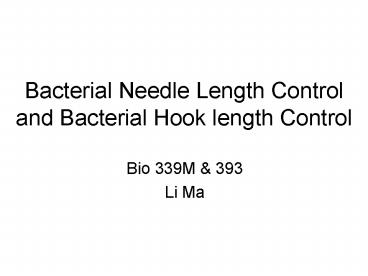Bacterial Needle Length Control and Bacterial Hook length Control - PowerPoint PPT Presentation
1 / 26
Title:
Bacterial Needle Length Control and Bacterial Hook length Control
Description:
Bacterial Needle Length Control and Bacterial Hook length Control. Bio 339M & 393. Li Ma ... Different wildtype YscP gives different needle length ... – PowerPoint PPT presentation
Number of Views:142
Avg rating:3.0/5.0
Title: Bacterial Needle Length Control and Bacterial Hook length Control
1
Bacterial Needle Length Control and Bacterial
Hook length Control
- Bio 339M 393
- Li Ma
2
Diagrams of known positions of major flagella
components (A) and established and hypothetical
TTSS functional homologs (B). Functions of
proteins conserved in both systems are marked by
similar position, shading, and coloring whether
they share sequence homologies or not. Those TTSS
components for which no sequence homology or
experimental evidence exists to establish their
relation to the similarly positioned and colored
flagella components in A are shown transparently
in B. Adapted from http//www.pnas.org/content/1
00/6/3027/F1.expansion
3
- ATP dependent Yops (Yersinia outer proteins)
secretion - Needle length is tightly controlled
TTSS of Yersinia pestis http//www.genome.jp/dbget
-bin/get_pathway?org_nameypkmapno03070
4
Tow proposed models for Hook/Needle length
control
YscF
- C-ring measuring cup model
- Molecular ruler model
YscP
5
Is YscP required for needle length control ?
6
YscP is required for needle length control
Journet et al. science 2003
7
Different wildtype YscP gives different needle
length
which one of the two models do you think this
data favors?
Journet et al. science 2003
8
Construct mutant YscPs with different length
will these YscPs give different needle length ?
9
What does YscP do?
Conclusion 1 YscP serves as a ruler determining
the length of the needle
Journet et al. science 2003
10
How does it do its job?
Conclusion 2 YscP is secreted and associated
with newly synthesized needles
Journet et al. science 2003
11
What about the flagella hook length control ?
12
Two important events in flagella hook length
control
FliK
FlhB
flagella basal body
FlhB
13
Is FliK a molecular ruler determining the hook
length ?
- FliK and FlhB are required for hook length
control - fliK- gives rise to polyhooks
- FliK's N-terminal domain has a high affinity with
the hook capping protein - FliK's C-terminal domain can interact with the
gate component FlhB - FliK-N gives rise to polyhooks w/o filaments
while FliK-C gives rise to polyhooks w filaments - Large population of hooks of wildtype length in a
fliK- strain
14
the same strategy from the wildtypes to the
mutants
15
Shibata et al. Molecular Microbiology 2007
16
Shibata et al. Molecular Microbiology 2007
17
N
C
Shibata et al. Molecular Microbiology 2007
18
Shibata et al. Molecular Microbiology 2007
19
Shibata et al. Molecular Microbiology 2007
20
Wildtype
Shibata et al. Molecular Microbiology 2007
21
As of now, FliK behaves the same as YscPit is a
molecular ruler
However
22
Shibata et al. Molecular Microbiology 2007
23
Shibata et al. Molecular Microbiology 2007
24
Arguments against the "ruler" modela) from the
data presented hereb) from biochemistry
textbooks
25
YscF
YscP
Arguments against the "cup" modelthe FlgD-
mutant
26
FliK is an internal molecular ruler































